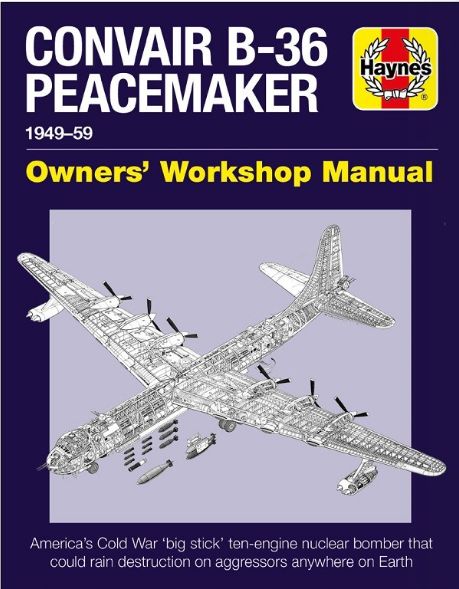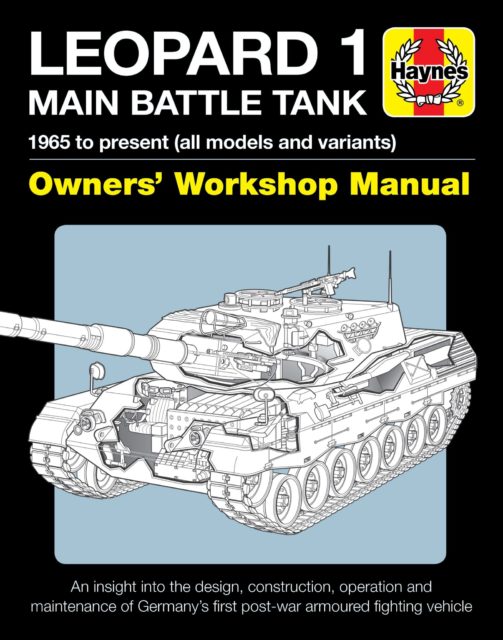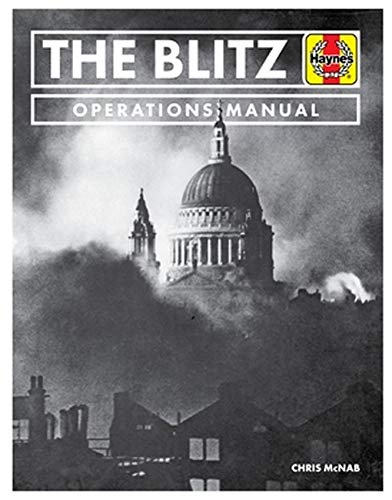I once collected a multi-volume aviation history part work we do not see the like of today thanks to the glories of the worldwide web and other diversions. It was there that I first saw a photo of a Convair B-36 Peacemaker. Now, this was at the tail end of the 1970s when the B-52 was king and while the glorious Avro Vulcan was wowing the airshow circuit I inhabited. But the huge B-36 made an impact upon me and I would still like to see one in the flesh.
However, I note that only four complete airframes survive from over three hundred and eighty-four constructed.
David Baker’s immensely detailed book fulfils the remit of all we have come to expect from Haynes’ Owners’ Workshop Manual series. He takes the time to set the aircraft into context and runs through the history of US bomber development from the pioneering Billy Mitchell through to the creation of Strategic Air Command and the age of nuclear weapons. I like the way he includes prototypes that might be considered to be rivals to Convair’s giant including the intriguing flying wings built by Northrop.
He considers the place of the B-47 and it becomes clear how it and the B-36 were not so much rival airframes, but partners of a sort within the strategic thinking of the time. I cannot fail to be impressed by the idea that the Convair bomber was conceived so American air power could reach out literally all over the world.
It seems to be the apogee of all that Stanley Baldwin had told the man in the street to fear with his warning “the bomber will always get through” during the 1930s. But within a decade of entering service the B-36 was old news. It’s replacement, the Boeing B-52, is still with us.
It feels more than a little topsy-turvy to rejoice in an aircraft designed to deliver nuclear weapons, but the B-36 is such an impressive beast. The author takes us through the complete cycle of the aircraft from drawing board to service life. The evolution of the aircraft with the marks and variants is explained in detail.
The use of archive photography is up to the usual standard of Haynes and this element does a lot to illustrate the innards of an incredibly complicated airframe.
These books go from the sublime to the ridiculous with their choice of subject matter and there is no question that the notion of operating something like the B-36 is out there in the realms of fantasyland. The four survivors are museum pieces and we’re unlikely to see one fly. We could do worse than to see the James Stewart movie Strategic Air Command to get a little closer to these monsters.
The consistently impressive standard of presentation and attention to detail make this book a winner. The author manages to cram in a great deal, but the narrative flows well and the whole project has been planned with great care. If you are a devotee the leviathans of the Cold War era you will not be disappointed. There is much here for students of the period looking for details to flesh out their essays.
This is certainly one of the most intriguing books in this range I have seen for a while and it recommends itself without much embellishment from me.

CONVAIR B-36 PEACEMAKER
1949-1959
Owner’s Workshop Manual
By David Baker
JH Haynes & Co Ltd
ISBN: 978 1
Moving on, we have a few volumes I have been sitting on during the unwelcome hiatus arising from my inability to review books during this rotten pandemic. Apologies to the authors for the brief nature of this round up.
First up we have the Leopard 1 MBT. Let us not beat about the bush and say what an important tank this old lump is. I have had the pleasure to see one or two running on the UK circuit in recent years and there is little question the design of the tank has been an absolute winner. We can talk about German efficiency all day, but the proof is in the pudding with the Leopard 1.
The authors have covered the tank in detail, taking us through the various strands of design, prototypes and eventual selection through to production and service life with the Bundeswehr and countless other armies. I particularly liked the sections on international users of the tank. The Leopard 1 and its angular cousins will be with us for a very long time. If post WW2 armour is your thing then this volume is a must have.

LEOPARD 1 MAIN BATTLE TANK
1965 to present (all models and variants)
Owners’ Workshop Manual
By Michael K Cecil and Michael Shackleton
Haynes Publishing
ISBN: 978 1 78521 637 4
We move on to one of the most venerable weapons from battlefields of the 20th Century – the classic Vickers machine gun. Martin Pegler’s book falls into the enthusiasts’ manual branch of the Haynes imprint and I’m quite sure there are very few people who would be able to own and operate such a weapon. Ever tightening gun laws appear to make it nigh on impossible as far as my country is concerned.
The author takes back to the days of Hiram Maxim, the American engineer who designed the first machine gun to enter military service and how his work led to the creation of the classic Vickers gun that remained in British service into the 1960s. I well remember a story of one gun that was set up and fired continuously for a week without trouble.
I can only assume this came at a time when the .303 inch round was about to be surpassed by 7.62mm ammunition for the GPMG and FN self-loading rifle meaning there was an awful lot of .303 ammo to use up.
We see the classic gun in full detail and follow it’s progress through the two world wars. The author looks at variants and gives us a close up look at operation and maintenance. We learn what it was like to use the gun and even get a peak at the author on a range with the Vickers he owned back in the 1980s.
It is clear he knows the weapon intimately and this translates through the quality of the text and the care taken in making this excellent book.
There is certainly enough anatomical stuff to match the more general aspects of history and, once again, the usage of illustrations is perfect. You might not to be able to a gun like this, but this book will get you very close to one. This volume is a winner for gun buffs as much as it is for people interested in the history of warfare.

VICKERS-MAXIM MACHINE GUNS
1886-1968 (all models)
By Martin Pegler
Haynes Publishing
ISBN: 978 1 78521 563 6
We finish with a book I started reviewing months ago. This year has seen the 80th anniversary of key events in the early phase of World War 2 and as a Brit I can hardly ignore the Blitz. Members of my family lived through it and experienced things my mother can still recall in detail (she is 91 years old).
It was a period that defined the London of my mum’s childhood and the legacy of it was around me in the most tangible of ways when I was a young lad. But London, like the other British towns and cities attacked by the Luftwaffe is much changed and the signs of those terrible days have largely been erased by modern developments. The bombsites I knew as a kid are all gone.
The prolific Chris McNab takes us through the efforts of civil defence organisations and the military to counter the effects of bombing raid. This was a huge national effort that impacted on everybody in the country in some way.
The book offers a blueprint of how it all worked and the coverage is as in depth as we should expect from this series. The author is super-efficient at this sort of stuff and takes the trouble of providing a bibliography of further reading. If I may I would certainly add Richard Collier’s The City That Wouldn’t Die and MJ Gaskin’s Blitz to the list – but this is a purely subjective element on my part.
There is little doubt traditional narratives flesh out the story leaving a manual like this to dot the Is and cross the Ts. The reality is more subtle, because this book actually meets the narrative formats more than half way. For the fourth time running I will remind you the use of illustrations plays an important part in the overall package.
This is a great book and while I’m tempted to say I’d left the best for last, all four of the books I’ve described, here, are very impressive. They leave me wondering what Haynes will not take on. Keep in mind much of their output is not of a military nature so the possibilities could be endless. Be impressed.

THE BLITZ
Operations Manual
By Chris McNab
Haynes Publishing
ISBN: 978 1 78521 640 4
Reviewed by Mark Barnes for War History Online
